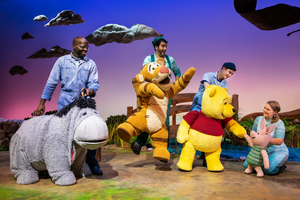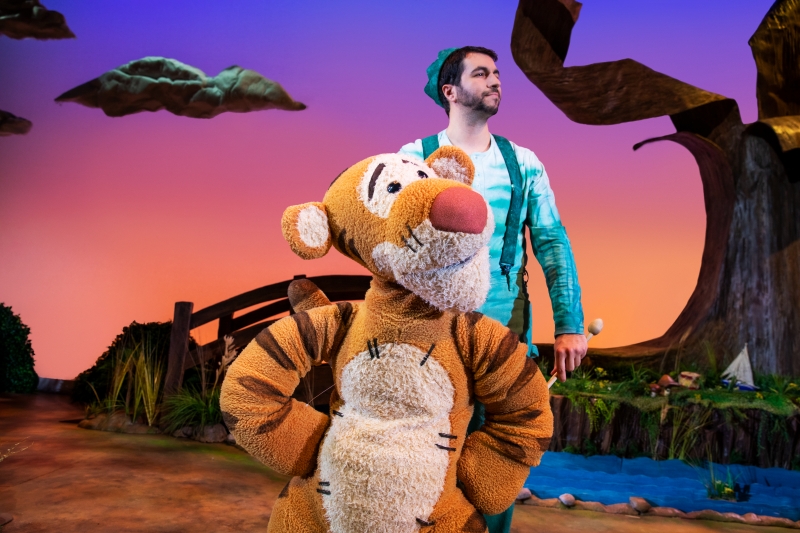Review: WINNIE THE POOH: THE NEW MUSICAL STAGE ADAPTATION at The Hundred Acre Wood Theatre at Theatre Row
Now Playing in NYC: Beloved Characters Come to Life as Giant Puppets

On a particularly blustery Saturday afternoon, I dodged the perils of 42nd Street's notorious foot traffic (and umbrellas) to arrive at Theatre Row, where the newly renamed Hundred Acre Wood Theatre transported me to a magical place of innocence, wonder, and cherished childhood memories.
It's a total sensory experience from the moment one enters the theatre. First, you're engulfed by the sounds of frogs and crickets. David Goldstein's set glows with Jamie Roderick's warm, inviting lighting and evokes the Disney animated films and Ashdown Forest in Sussex, England that served as author A.A. Milne's inspiration. It makes you feel like you've entered an enchanted woodland. And that's before the show begins.
Upon the entry of a certain familiar "tubby little cubby all stuffed with fluff," the audience of kids of all ages (including a good number of grown-ups without children companions) erupted with glee as if a rockstar or celebrity had graced the stage. Not that such a reception would go to the head of the "bear of very little brains." But the musical's Pooh is actually -- like the other stuffed animal characters made sentient by the human boy Christopher Robin's imagination -- two performers in one.

One Winnie the Pooh is the actor and singer, Jake Bazel (who also provided additional dialogue to the script). Bazel's warm, soft, buttery voice honors iconic Poohs before him like Sterling Holloway and Jim Cummings while making the character his own. His kind face is innocence-personified, but his slim build contrasts the rotund teddy.
The other Pooh bear is one of Rockefeller Productions' life-sized puppets created by a talented team led by Matthew Lish and the production's playwright, director, and creative director of the puppet department, Jonathan Rockefeller.
The puppets are handled Avenue-Q style (don't fret, folks, that's as far as the similarities go with the Tony Award-winning adult puppet show). The human actors are visible and speak or sing while performing the demanding and athletic feat of operating a giant plushie with both hands and feet. It's a marathon of activity for the performers, and most were understandably perspiring from the effort midway through. The puppets, however, made it look easy. They did not break a sweat despite their sometimes perilous situations.
.jpg)
The premise is simple -- Pooh feels a "rumbly" in his "tumbly" and craves honey. But his human child pal Christopher Robin (played with guileless joy by Max Lamberg at my performance) is off to school. This sparks an adventure where Pooh sets off in search of the sweet golden liquid and passes through the four seasons with his friends until Christopher Robin finally returns in the summer and gives him a jar of the long-awaited sugary bliss.
Each season ushers in new adventures and magical moments. Kids and adults will recognize the songs, storylines and characters from the books and animated films. The main musical numbers are bright, brief, and punchy earworms that earned Grammys for Richard M. and Robert B. Sherman. (The Sherman Brothers are responsible for the original Pooh songs, among other hits for Disney musicals).
New music includes "The More It Snows (Tiddley Pom)" by Carly Simon, "Sing-Ho (for the Life of a Bear)" by Nate Edmonson (who provides the show's score and additional lyrics as well), and Winnie the Pooh's "Hums" by original author A.A. Milne.
Like most children's books written by adults, the seemingly simple tales have hidden meanings and philosophical layers that reflect the human experience. Other notable books that have been adapted numerous times include The Velveteen Rabbit, Charlotte's Web, The Little Prince, Coraline, and How Do You Live? (recently translated from Japanese and the basis of Hayao Miyazaki's final film for Studio Ghibli).
.jpg)
Fascination with the philosophy of Pooh and his friends have inspired other books (The Tao of Pooh and The Te of Piglet, both by Benjamin Hoff) and theories that the characters are based on various mental illnesses ("Pathology in the Hundred Acre Wood: a neurodevelopmental perspective on A.A. Milne," published in the Canadian Medical Association Journal in 2000). A bit intense, perhaps, but it one can find some truth in these explorations.
Psychiatrist Carl Jung might have called these characters "archetypes." I think of them as personalities. Who hasn't known an energetic attention-seeker like Tigger, a know-it-all Owl type, or controlling perfectionist like Rabbit? (Here's a fun game: ask friends and family which single or combination of Pooh characters they identify with and why. Try it!)
But be they embodiments of archetypes, personalities, or mental disorders, the whole (human and puppet) cast is spectacular. It was hard to choose where to look, at the puppet or the person. In addition to Bazel's spot-on Pooh, Kristina Dizon played the nurturing mother Kanga and several other creatures like bees, birds, and butterflies.
.jpg)
Kirsty Moon's tender voice and gentle ways made both Piglet and Roo come to life with sincerity and likability. Chris Palmieri's athletic, lisping interpretation of Tigger often stole the show and inspired spontaneous applause. (But then again, attracting attention is one of the many things Tiggers do best!). I was particularly struck by the vocal and physical challenge for Emmanuel Elpenord, who performs triple-duty as Eeyore, Rabbit, and Owl (with assistance from Dizon). Elpenord managed to make each character extremely distinctive and authentic to the originals.
The design and construction of the puppets are nothing less than remarkable. The Rockefeller Productions team combined elements from E.H. Shepard's original illustrations and Disney's animated characters then added special touches that made the fuzzy friends feel less like cartoon animals than what they really are -- plush toys come to life. The result is that they all appear even cuter, sweeter, and a bit shabbier, too, like a well-loved toy.
Lindsay Williams paid equal attention to detail in costuming the human actors. Each performer's youthful outfits have elements that mimic their puppet counterparts. Dizon's Kanga has patchwork accents, Moon's Piglet wears a striped, mock-neck top, and Palmieri's Tigger dons a jughead-style crown cap and a shirt with abstract, painterly stripes.

The musical's puppets that were the most strikingly different in appearance from the animated films are Eeyore, Rabbit, Owl, Kanga and Roo. This is a welcome change as they feel more expressive, charming, imaginative, and alive. There is a sense of evolution, authenticity, and deliberateness in these choices. Of course, if you fall in love (as I did with Eeyore), you can take a smaller version home with you.
Though some might feel that showing the voices and faces behind the puppets breaks the mystique, to me, it fosters a sense of play and imagination games, where children enact different characters without the aid of customized costumes and complex puppetry skills.
After all, kids are the masters of suspension of disbelief until too much CGI and screen time alter their innocence and expectations. One of the most marvelous things about this new adaptation of Winnie the Pooh is the production's perfection in its simplicity. There is no sense that the show is trying too hard; its wonder and magic are palpable and as real as toys that speak and have adventures because you believe they can.
Winnie the Pooh: The New Musical Stage Adaptation is magical, sweet as honey, and full of humor. It's a wholesome, delightful, enchanting piece of theatre for the young and young at heart to celebrate the seasons, friendships, adventures, and the wonders of the imagination.
.jpg)
Reader Reviews

Videos
